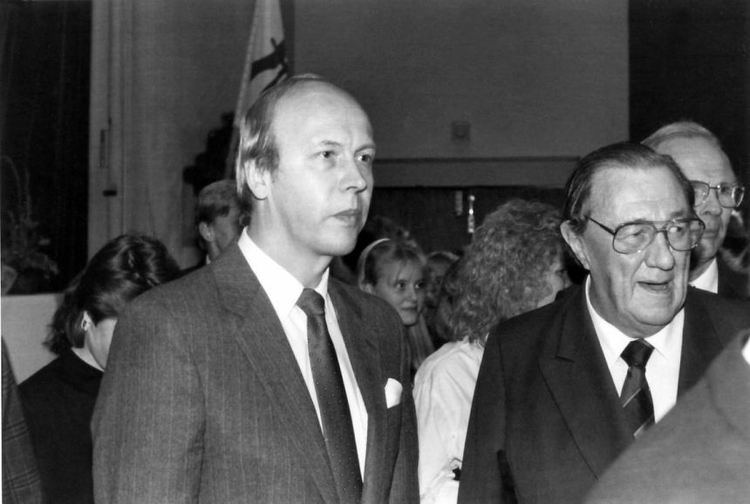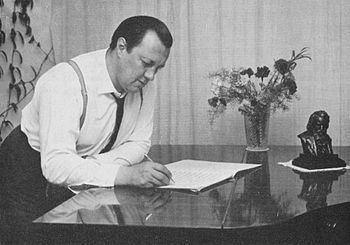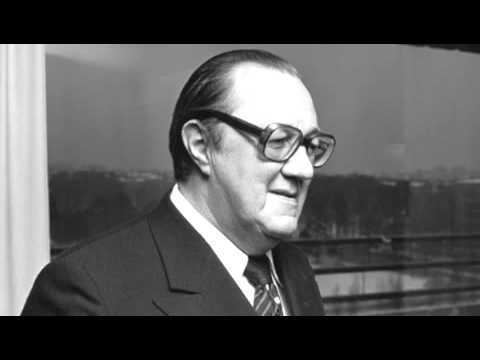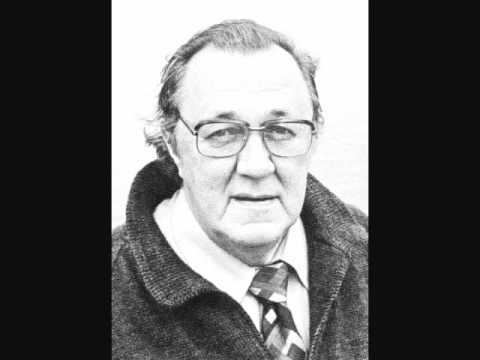Name Joonas Kokkonen | Role Composer | |
 | ||
Compositions The Last Temptations, The Last Temptations, Viimeiset kiusaukset: Ukko-Paavon virsi, Viimeiset kiusaukset: Ukko-Paavon virsi, Symphony no 4: III Adagio, Symphony no 4: III Adagio, Opus sonorum: III Allegro non troppo, Opus sonorum: III Allegro non troppo, Symphony no 2: III Andante, Symphony no 2: III Andante, Symphony no 2: I Adagio non troppo, Symphony no 2: I Adagio non troppo, Music for String Orchestra: III Adagio religioso, Music for String Orchestra: III Adagio religioso, Requiem: II Kyrie eleison Allegro, Requiem: II Kyrie eleison Allegro, Symphony no 1: I Moderato, Symphony no 1: I Moderato, Opus sonorum: I Moderato, Opus sonorum: I Moderato, Opus sonorum: II Adagio non troppo, Opus sonorum: II Adagio non troppo, Cello Concerto: I Moderato mosso - Allegro, Cello Concerto: I Moderato mosso - Allegro, Cello Concerto: III Adagio, Cello Concerto: III Adagio, Symphony no 3: I Andante sostenuto, Symphony no 3: I Andante sostenuto, Symphony no 1: III Allegro, Symphony no 1: III Allegro, Cello Concerto: II Allegretto, Cello Concerto: II Allegretto, Requiem: IV Domine Jesu Christe Moderato, Requiem: IV Domine Jesu Christe Moderato, The Hades of the Birds: III Sade (The Rain), The Hades of the Birds: III Sade (The Rain), Requiem: Requiem aeternam, Requiem: Requiem aeternam, Musiikkia jousiorkesterille: II Allegro molto – Poco piu lento – Tempo I, Musiikkia jousiorkesterille: II Allegro molto – Poco piu lento – Tempo I, Symphony no 3: III Allegretto moderato, Symphony no 3: III Allegretto moderato, Sinfonisia luonnoksia: III Religioso Andante, Sinfonisia luonnoksia: III Religioso Andante, Requiem: I Requiem aeternam Andante, Requiem: I Requiem aeternam Andante, Requiem: III Tractus Andante, Requiem: III Tractus Andante, Sinfonia da camera: IV Andante, Sinfonia da camera: IV Andante, Opus sonorum, Opus sonorum, Cello Concerto: V Allegro vivace, Cello Concerto: V Allegro vivace, Sinfonia da camera: I Moderato, Sinfonia da camera: I Moderato, Symphony no 3: IV Adagio, Symphony no 3: IV Adagio, Symphony no 1: IV Adagio, Symphony no 1: IV Adagio, Laudate Dominum, Laudate Dominum, Requiem: VIII In Paradisum Andante, Requiem: VIII In Paradisum Andante, Sinfonisia luonnoksia: I Lamento Andante, Sinfonisia luonnoksia: I Lamento Andante, The Hades of the Birds: II Lintujen tuonela (The Hades of the Birds), The Hades of the Birds: II Lintujen tuonela (The Hades of the Birds), Musiikkia jousiorkesterille: I Moderato – Piu lento – Tempo I, Musiikkia jousiorkesterille: I Moderato – Piu lento – Tempo I, Sinfonisia luonnoksia: II Pezzo giacoso Allegro, Sinfonisia luonnoksia: II Pezzo giacoso Allegro, Music for String Orchestra: IV Allegro, Music for String Orchestra: IV Allegro, Lux aeterna, Lux aeterna, Symphony no 2: III Allegretto moderato, Symphony no 2: III Allegretto moderato, Requiem: V Hostias et preces Allegretto, Requiem: V Hostias et preces Allegretto, Symphony no 2: IV Allegro vivace, Symphony no 2: IV Allegro vivace, Symphony no 3: II Allegro, Symphony no 3: II Allegro, Symphony no 2: II Allegro, Symphony no 2: II Allegro, Symphony no 4: I Moderato, Symphony no 4: I Moderato, Sinfonia da camera: III Molto vivace, Sinfonia da camera: III Molto vivace, Requiem: VI Sanctus & Benedictus Allegro moderato, Requiem: VI Sanctus & Benedictus Allegro moderato, Requiem: VII Agnus Dei Moderato, Requiem: VII Agnus Dei Moderato, Requiem: IX Lux aeterna Adagio, Requiem: IX Lux aeterna Adagio, The Hades of the Birds: I Taydellisyyden maassa (In the World of Perfection), The Hades of the Birds: I Taydellisyyden maassa (In the World of Perfection), Cello Concerto: IV Cadenza (Adagio), Cello Concerto: IV Cadenza (Adagio), Sinfonia da camera: II Allegro non troppo, Sinfonia da camera: II Allegro non troppo Similar People Osmo Vanska, Sakari Oramo, Leif Segerstam, Okko Kamu, Soile Isokoski | ||
Joonas kokkonen lux aeterna luca massaglia organ
Joonas Kokkonen ( pronunciation ) (November 13, 1921 – October 2, 1996) was a Finnish composer. He was one of the most internationally famous Finnish composers of the 20th century after Sibelius; his opera The Last Temptations has received over 500 performances worldwide, and is considered by many to be Finland's most distinguished national opera.
Contents
- Joonas kokkonen lux aeterna luca massaglia organ
- Joonas kokkonen lux aeterna 1974 eero richmond organ wmv
- Life
- Music and influence
- Orchestral
- Concertante
- Chamber
- Piano
- Organ
- Vocal
- Choral
- Opera
- References

Joonas kokkonen lux aeterna 1974 eero richmond organ wmv
Life

Joonas was born in Iisalmi, Finland, but spent the latter part of his life in Järvenpää at his home, which was known as "Villa Kokkonen", designed by Alvar Aalto and finished in 1969. He served in the Finnish army during World War II with great distinction. He received his education at the University of Helsinki, and later at the Sibelius Academy, where he afterwards taught composition; his students there included Aulis Sallinen. In addition to his activities as a composer, he made a significant and powerful impact on Finnish cultural life, serving as a chairman and organizer, heading organizations such as Society of Finnish Composers, the Board of the Concert Centre, and others. His purpose was always to improve music education, as well as the status and appreciation of classical music as well as Finnish music. In the 1960s and early 1970s he won numerous prizes for his work. He was appointed to the prestigious Finnish Academy upon the death of Uuno Klami. His composition activity slowed down greatly after the death of his wife and increased alcohol consumption. He had long planned a Fifth Symphony but nothing was ever committed to paper and it died with him.

The date of his death has been variously reported as October 1, 1996 (New Grove Dictionary, and various internet sources); October 2, 1996 (many internet sources, including the Finnish Music Center); and October 20, 1996 (New Grove Dictionary of Opera). According to his biographer Pekka Hako, he died on October 2, in the early hours of the day.
Music and influence

Even though he studied at the Sibelius Academy, he was mainly self-taught in composition. Usually his compositions are divided into three style periods: a neo-classical early style from 1948 to 1958, a relatively short middle period twelve-tone style from 1959 to 1966, and a late "neo-Romantic" style of free tonality which also used aspects of his earlier style periods, which began in 1967 and lasted for the rest of his life.
Most of his early music is chamber music, and includes a Piano Trio and a Piano Quintet; the style is contrapuntal and influenced by Bartók, but looks back to Renaissance and Baroque models as well. In the second style period he wrote the first two of his four symphonies. Although he used twelve-tone technique, he avoided orthodoxy by occasionally using triads and octaves; he also liked to use the row melodically, giving the successive pitches in the same tone color (many other composers of 12-tone music split the row between different voices).
In the third style period Kokkonen wrote the music that made him internationally famous: the last two symphonies, the ...durch einen Spiegel for twelve solo strings, the Requiem, and the opera The Last Temptations (1975) (Viimeiset kiusaukset), based on the life and death of the Finnish Revivalist preacher Paavo Ruotsalainen. The opera is punctuated with chorales which refer back to Johann Sebastian Bach, and which are also reminiscent of the African-American spirituals used for a similar purpose in Michael Tippett's oratorio A Child of Our Time. The opera was staged at the Metropolitan Opera in New York in 1983.
